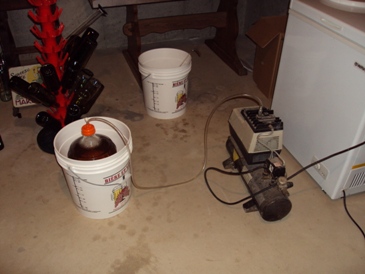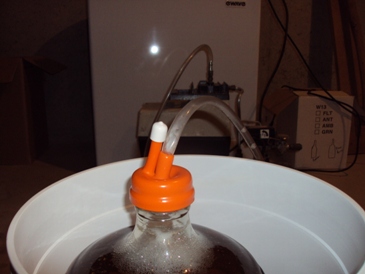KCWortHog
Well-Known Member
I went to three different mead-oriented sessions/functions while in Minneapolis for NHC: the BJCP banquet, a Varietal Mead session, and Meadmaker of the Year panel. I'm sure some of you here did as well.
1. BJCP banquet. Though there were some logistical issues with the event itself, the content of the mead portion was an excellent experience. Basically, there was a ton of semi-sweet mead available, along with pipettes in jars of various additives around the perimeter of the room (and on a table in the middle). Additives were basically tinctures of juniper, rose, ginger, mint, tannin, acid, oak, and other various flavorings that can be used to manipulate the flavors of mead. I learned that rose flavoring goes a LONG way. So does mint. Ginger pairs with mead extremely well, and it takes a LOT of juniper extract to alter the flavor of a mead.
But probably the biggest take-away I got from this was that mead with acid & tannin added becomes much more complex and interesting than mead without. I highly recommend experimenting with taking a measured sample of traditional mead, adding measured amounts of acid blend & tannin to your liking, and finding the right proportions to make your mead stand out. Then scale up & add those amounts to your batch.
On the same note, it seems that the most reliable way to make a good-tasting metheglin is not to add any herbs or spices during fermentation, but instead to make an extract by "steeping" your selected ingredient in a neutral spirit (like vodka) for a couple of weeks, then adding a measured amount to your mead until it tastes right. Then scale up & add that amount to your batch. Way more reliable than guessing pre-fermentation amounts.
2. Varietal Meads: Gordon Strong & Susan Ruud. We tasted different honeys and the meads made from each. We tasted orange blossom, tupelo, basswood, white sage, mesquite, and... I think there was 1 more but my memory fails me.
The main thing I took from this was that you should REALLY taste your honey before making a mead out of it. Basswood smelled like hay to me and the mead tasted like minerals. OK, but not great. They were all fine, but the Orange Blossom and Tupelo really stood out as the shining stars of varietal mead. Though I'd love to try sourwood some time, these were representative of typically-available honey.
3. Meadmaker of the Year panel: Steve Piatz, Curt Stock, Steve Fletty, Thomas Eibner, and Joe Formanek.
This was basically a Q&A forum and there were a lot of questions. I asked Eibner how he did his award-winning braggot (add honey to fermenting product, or make beer & mead then blend) and he added the honey to the fermenter after cooling the wort, then pitched the yeast & fermented it out. I think I'll still stick to making braggots by blending beer & mead, but wanted to mention that this approach clearly works.
If there was ONE thing that I had to list as my #1 takeaway from this session, it's DEGAS. Piatz gave everyone a handout, which should be available when all presentations are posted (here). CO2 is toxic to yeast, so it makes sense that removing as much CO2 as possible assists fermentation. I was degassing by stirring, but it's clear now that it's not nearly enough - it needs to last until CO2 bubbles no longer rise to the surface. Piatz stated that he ferments a 5-gallon batch of mead in a food-safe garbage can - and when he degasses (with a drill-operated lees stirrer), foam rises nearly to the top of the container. That is a LOT of foam!
When asked about nutrient additions, it seemed that everyone on the panel did something slightly different. All of them did nutrient additions - some with KOH, some without. Piatz claimed that he never tests his pH (not sure I believe that, but that's what he said). Fletty said he doesn't do staggered nutrients; he just adds them all at once. But the one thing they ALL did was degas.
It's clear to me now that degassing is just as important as nutrient additions, but it doesn't get nearly as much attention. And not just stirring, but vigorous degassing with a lees stirrer to remove as much CO2 as possible. The panel recommended degassing several times a day, if possible. (maybe I can tell my boss I have to go home 3 times a day to de-gas... think he'd object? )
)
Everyone on the panel did fruit in primary. There's some disagreement on how much aroma you're losing in fermentation, but the general consensus is that you don't lose enough to ruin your mead.
The panel also all recommended SuperKleer KC for fining.
As for backsweetening, the general consensus was to backsweeten with the same honey you used for the base. Piatz said he backsweetens with sack mead, but I would think that'd require having a **** ton of sack mead sitting around for backsweetening... It was suggested at one of the social events by Ruud that you can still get a mead with varietal properties by making a mead with any old base honey (wildflower, clover), ferment it out, then backsweeten with a varietal for flavor & aroma. Sure beats spending $250 on a bucket of tupelo.
That's all I got! Enjoy :rockin:
1. BJCP banquet. Though there were some logistical issues with the event itself, the content of the mead portion was an excellent experience. Basically, there was a ton of semi-sweet mead available, along with pipettes in jars of various additives around the perimeter of the room (and on a table in the middle). Additives were basically tinctures of juniper, rose, ginger, mint, tannin, acid, oak, and other various flavorings that can be used to manipulate the flavors of mead. I learned that rose flavoring goes a LONG way. So does mint. Ginger pairs with mead extremely well, and it takes a LOT of juniper extract to alter the flavor of a mead.
But probably the biggest take-away I got from this was that mead with acid & tannin added becomes much more complex and interesting than mead without. I highly recommend experimenting with taking a measured sample of traditional mead, adding measured amounts of acid blend & tannin to your liking, and finding the right proportions to make your mead stand out. Then scale up & add those amounts to your batch.
On the same note, it seems that the most reliable way to make a good-tasting metheglin is not to add any herbs or spices during fermentation, but instead to make an extract by "steeping" your selected ingredient in a neutral spirit (like vodka) for a couple of weeks, then adding a measured amount to your mead until it tastes right. Then scale up & add that amount to your batch. Way more reliable than guessing pre-fermentation amounts.
2. Varietal Meads: Gordon Strong & Susan Ruud. We tasted different honeys and the meads made from each. We tasted orange blossom, tupelo, basswood, white sage, mesquite, and... I think there was 1 more but my memory fails me.
The main thing I took from this was that you should REALLY taste your honey before making a mead out of it. Basswood smelled like hay to me and the mead tasted like minerals. OK, but not great. They were all fine, but the Orange Blossom and Tupelo really stood out as the shining stars of varietal mead. Though I'd love to try sourwood some time, these were representative of typically-available honey.
3. Meadmaker of the Year panel: Steve Piatz, Curt Stock, Steve Fletty, Thomas Eibner, and Joe Formanek.
This was basically a Q&A forum and there were a lot of questions. I asked Eibner how he did his award-winning braggot (add honey to fermenting product, or make beer & mead then blend) and he added the honey to the fermenter after cooling the wort, then pitched the yeast & fermented it out. I think I'll still stick to making braggots by blending beer & mead, but wanted to mention that this approach clearly works.
If there was ONE thing that I had to list as my #1 takeaway from this session, it's DEGAS. Piatz gave everyone a handout, which should be available when all presentations are posted (here). CO2 is toxic to yeast, so it makes sense that removing as much CO2 as possible assists fermentation. I was degassing by stirring, but it's clear now that it's not nearly enough - it needs to last until CO2 bubbles no longer rise to the surface. Piatz stated that he ferments a 5-gallon batch of mead in a food-safe garbage can - and when he degasses (with a drill-operated lees stirrer), foam rises nearly to the top of the container. That is a LOT of foam!
When asked about nutrient additions, it seemed that everyone on the panel did something slightly different. All of them did nutrient additions - some with KOH, some without. Piatz claimed that he never tests his pH (not sure I believe that, but that's what he said). Fletty said he doesn't do staggered nutrients; he just adds them all at once. But the one thing they ALL did was degas.
It's clear to me now that degassing is just as important as nutrient additions, but it doesn't get nearly as much attention. And not just stirring, but vigorous degassing with a lees stirrer to remove as much CO2 as possible. The panel recommended degassing several times a day, if possible. (maybe I can tell my boss I have to go home 3 times a day to de-gas... think he'd object?
Everyone on the panel did fruit in primary. There's some disagreement on how much aroma you're losing in fermentation, but the general consensus is that you don't lose enough to ruin your mead.
The panel also all recommended SuperKleer KC for fining.
As for backsweetening, the general consensus was to backsweeten with the same honey you used for the base. Piatz said he backsweetens with sack mead, but I would think that'd require having a **** ton of sack mead sitting around for backsweetening... It was suggested at one of the social events by Ruud that you can still get a mead with varietal properties by making a mead with any old base honey (wildflower, clover), ferment it out, then backsweeten with a varietal for flavor & aroma. Sure beats spending $250 on a bucket of tupelo.
That's all I got! Enjoy :rockin:





